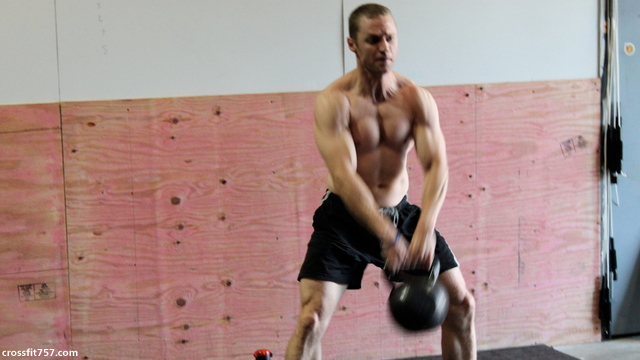1 - 5 Reps Per Set
Maximum Strength, Power and Speed Training Set need to be performed in this Repetition Range.
Kettlebell Swing
Kettlebell Swings for Power use the same 1 - 5 Repetition per set. Since the swing employs a stretch reflex action, more than 1 Repetition is needed. Thus, around 3 - 5 Repetitions per Kettlebell Power Set are more effective.
Part of the issue is that a fairly a heavy Kettlebell is required to maximize Power in a Kettlebell Swing; between one-third to 100% of an individuals body weight.
As an example, a 180 lb individual need to perform to perform a Kettlebell Swing with a Kettlebell that is 60 lbs (one-third) to 180 lbs (100%).
The Kettlebell Load Percentage was addresses in this post:
Kettlebells and wrestling sttength
As per Antti...
"...if one wants to develop power specifically and optimally then ten reps or seven is far too much."
"...there's nothing wrong with doing 10*10 sets of swings, they work great for multiple qualities, but I wouldn't say that it's the best way to develop power. "
Strength Training Percentages
The same Reps, Sets and Rest Periods are used for Maximum Strength Training, Power and Speed.
1) Maximum Strength
a) Reps: 1 - 5 Reps, around 1 - 2 Reps is optimal.
b) Load: 85% plus of 1 Repetition Max
c) Rest Periods: 3 minute and longer between Sets
2) Power Training
a) Reps: 1 - 5 Reps; around 1 - 2 Reps is optimal.
b) Load
Traditional Exercises (Squat, Bench, etc) 48 to 62% plus of 1 Repetition Max
Olympic Movements: 70 to 80% of 1 Repetition Max. Kettlebell Swings fall into this category.
c) Rest Periods: 3 minute and longer between Sets.
3) Speed Training
a) Reps: 1 - 5 Reps, around 1 - 2 Reps is optimal.
b) Load: 10 - 40% plus of 1 Repetition Max
c) Rest Periods: 3 minute and longer between Sets
4) Hypertrophy Training
a) Reps: 8 - 12 Reps or more.
b) Load: 60 - 80% plus of 1 Repetition Max
c) Rest Periods: Approximately 1 Minute between sets
5) Endurance Strength Training
a) Reps: 15 Reps or more.
b) Load: 40 - 60% plus of 1 Repetition Max
c) Rest Periods: Approximately 30 Seconds or less between sets
d) Endurance Training alone increased aerobic capacity at the expense of Speed, Power and Maximum Strength; all three drop like a rock during a Hypertrophy only phase.

